Entry Level Shark Helmet
There are dozens of motorcycle helmet brands and models to choose from today — and just as many reasons to select one over another.
Of course, there’s always the “Big Three” — Arai, HJC and Shoei — who have a deserved reputation for high-quality products and a commitment to safety.
But I’d put Shark Helmets right up there with the best.
This is based on my experiences with the brand and confirmed by conversations with European owners, Shark retailers and Shark Helmet company representatives.
Unfortunately, Shark is probably not as widely recognized in the U.S.A. as it should be.
So it’s important to note that Shark prides itself on its commitment to helmet safety technology that, I think, may be a step above and beyond many other helmet manufacturers.
That commitment includes what Shark calls a “cutting edge” research lab that studies topics like new helmet materials and the biomechanics of impact forces on the head.
They work closely with CEESAR, a European organization that studies the biomechanics of accidents to determine the causes of head trauma, based on studies of motorcycle accident and head injury data in Europe.
Shark has incorporated into their helmets many of the technologies that have been developed as a result of this research.
The story is long and complex, but Shark goes to great lengths to describe it, with inserts in the helmet boxes, information on their website and several videos.
The work has led to the development of special shell materials, padding and liners that are designed to bridge the gap between helmet materials that are either too hard and too soft.
This is designed to “absorb the maximum amount of energy in the minimum amount of time during the first impact on one spot”.
In effect, the company says that they have developed a special combination of helmet shell and lining material that absorbs impact neither too fast or too slow.
It has an “optimized rapid deceleration and impact absorption” (see an example photo of a Shark liner our Shark RSi Review).
It even appears that the “Shark” name may have been derived from the “Shark Fin Shocks” term that Shark uses to describe the shape of the EPS (expanded polystyrene) foam liner parts used in their helmets.
These are designed to “collapse, compress and flex during impact, absorbing more energy with more progressivity, and more precision than a solid piece”.
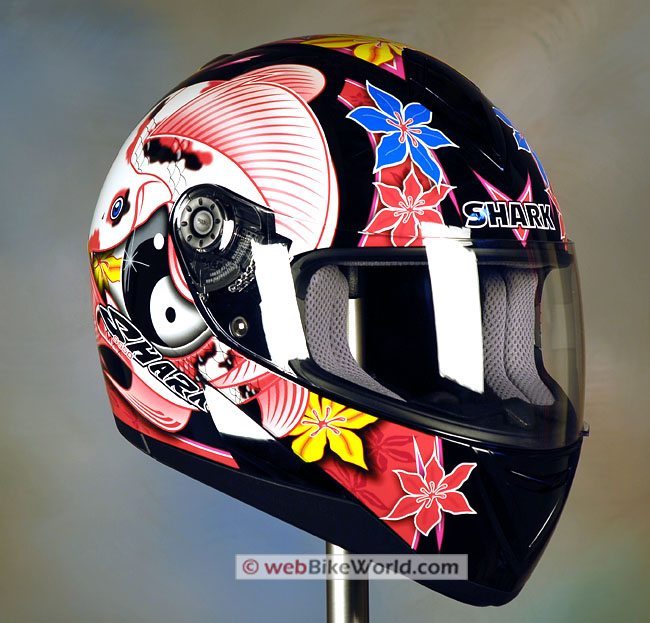
Where to Buy Shark S 650 Helmet
Check Reviews & Prices on Amazon Check Reviews & Prices On RevZillaSee More Motorcycle Helmets, Motorcycle Visor, Motorcycle Intercom
The significant difference is the multi-axial fiberglass and/or carbon fiber composite shell used in the higher end helmets (along with a few different accessory features), while the S 650 instead uses an injected thermoplastic resin shell to keep costs low.
Some motorcyclists have been deliberately choosing helmets with thermoplastic shells recently; a choice based on the Motorcyclists magazine report on helmet impact absorption (see the wBWMotorcycle Helmet FAQ page for more information).
My feeling is that one should study the matter carefully before making a crucial decision of this nature; just because a motorcycle helmet has a thermoplastic shell doesn’t necessarily mean it will absorb impact in the safest way possible.
The point of all this is that Shark seems to have an impressive commitment to motorcycle helmet safety, and that commitment is imbued into their entire product line, including the S 650, which is a relatively inexpensive helmet with a list price starting at $179.95 for solid colors.
Paint and Finish
Besides a couple of solid colors, the S 650 is available in a variety of graphic patterns. The helmet shown here carries the “Ikebana” graphics, and while they might not be everyone’s idea of a cool helmet design, I think it looks fantastic — and it sure is different.
Ikebana is the Japanese term for the art of formal flower arrangement, but the flowers and the Koi also bring back fond memories of my trip to Hawaii.
Like ’em or leave ’em, the graphics are perfectly applied, very colorful and the UV clear-coated finish seems to be nicely applied and should offer good protection to the finish. And the best part is that the Ikebana was only about 20 bucks more than the basic solid color S 650…
The helmet has every earmark of high quality except for one minor detail: a slightly loose top vent assembly. Otherwise, I can find no obvious flaws or imperfections in the way it is built, including the visor, lining, vent operation or anything else.
Score: I rate the Shark S 650 as excellent, considering the list price of the helmet (see ratings scale in the summary table at the bottom of this page). If it wasn’t for the slightly loose top vent housing, I would have scored it outstanding.
Helmet Shape and Fit
The S 650 seems to have the same internal shape as the Shark RSi we reviewed last year. I’d characterize it as a definite “long oval” shape.
This one is not for round-heads, in my opinion (see the wBW Motorcycle Helmet FAQ page for information on head shapes and choosing a motorcycle helmet).
In fact, I’m rather surprised at how “long oval-ish” it is — none of the regular webBikeWorld evaluators who live nearby have the correct head shape for this helmet; I’m closest to that fit, so I got the job.
In addition to having an internal shape like the Shark RSi, I’d say that the S 650 has a fit that is very similar to the long oval Arai Profile. But there’s a big difference: that helmet has a list price of around $475.00.
Actually, the long oval shape is great news, because there are very, very few (if any) long oval shaped helmets in this price range.
Most of the less expensive helmets are designed with a so-called “neutral” fit, which would theoretically amortize the costs over the largest possible customer base.
So if you’ve been having trouble finding a long oval shaped helmet at anything under Arai prices, it’s time to check out an S 650.
While the S 650’s liner isn’t as plush as the Arai, it’s probably a cut above some other less than $200 dollar helmets I can think of.
One curious feature that adds to the S 650’s long oval shape is the cheek pads, which are removable, but which extend in an “L” shape up above the rider’s ears.
Similar to the RSi, there are no ear “pockets” to speak of in the S 650, and the padding next to the ears is rather thin and backed by some hard plastic (see the photo below).
I think this makes the sides of the helmet seem narrower than they could be otherwise if the ears had a place to unfold. This also makes the helmet slightly more problematic for eyeglass wearers.
By the way, our recent article on eyeglass modifications can help with this issue, because the cut-down eyeglass frames help prevent discomfort on a helmet like this that can otherwise squash full-length frames between the rider’s ears and the helmet.
With both the RSi and now the S 650 using the long oval shape, I wonder which Shark helmets fit round heads?
The (now discontinued) RSR we reviewed several years ago had much more of a round internal shape and plenty of soft padding, but we haven’t tried the latest RSR2 or other Shark helmets, so I can’t comment on their shapes.
The main section of the liner is not removable, but since I’ve never had to replace a helmet liner anyway (we always wear some type of head liner because we share helmets), it’s not a problem for me.
So other than noting that we think the S 650 will fit long oval shaped heads best, everything else about the fit, finish and comfort is very good and, I think, better than most other helmets in this price range.
Score: I’ll give it an excellent rating (for those with long oval shaped heads) for shape and a very good for liner comfort.
Helmet Weight
The Shark S 650 in size XL weighs 1615 grams, or 3 lbs. 9.0 oz. This puts it pretty close to the median weight of the 73 helmets we’ve reviewed so far (see the wBW Motorcycle Helmet Weightspage for a comparison).
But, looking over the numbers brings up an interesting fact. Long-time webBikeWorld visitors may remember that it wasn’t too long ago when we raved about the light weight of the size large OGK FF-3 at 1623 grams.
But helmet technology has apparently advanced enough over the past few years that the size extra-large S 650, with its theoretically heavier thermoplastic shell, weighs even less.
The S 650 is also a lot lighter than, for example, the HJC CL-SP (1713 g), the Scorpion EXO-700(1733 g), the Joe Rocket RKT 101 (1737 g) and even the Scorpion EXO-400.
So the S 650 isn’t a super-lightweight by today’s standards, but it’s no slouch either.
The important fact is that it feels nicely balanced when riding and it also doesn’t have the directional effect I felt with the Shark RSi when riding, which is, I assume, a testament to the aerodynamic qualities of the S 650.
Score: I give the S 650 an excellent rating for its weight and weight distribution.
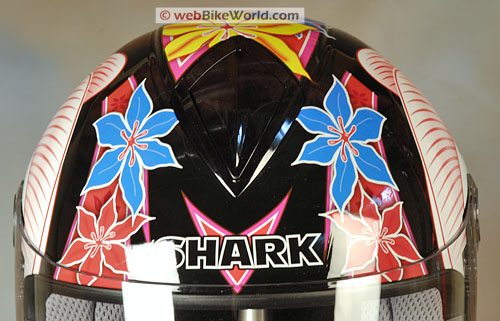
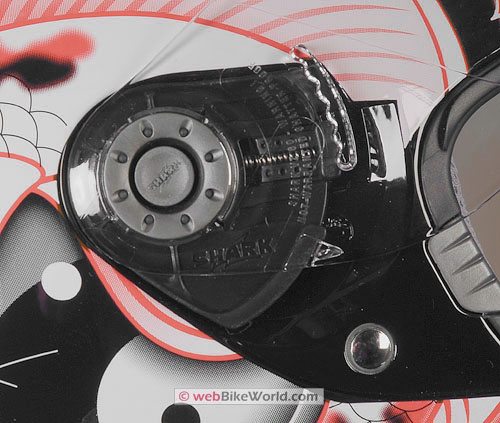
Where to Buy Shark S 650 Helmet
Check Reviews & Prices on Amazon Check Reviews & Prices On RevZillaSee More Motorcycle Helmets, Motorcycle Visor, Motorcycle Intercom
Face Shield
Shark has been working on their face shield removal system since we reviewed the RSR a few years ago, and it’s now about as simple as one could expect.
A small button is attached to the side of the face shield with a flexible membrane; the button slides into a a “U” shaped receiver on the side of the helmet and that’s all there is to it.
Press and hold the button and slide the face shield out; slide the button back in to the “U” receiver to put it back in.
The face shield is 2.2 mm thick according to Shark’s claims, backed up by our micrometer. It has excellent optical qualities and is without the excessive flexing we’ve noted on some other helmet face shields recently.
The detents that hold the face shield open in any of the 5 various positions are strong; my only complaint is that the first opening is too wide — I like face shields that can be cracked open just a touch to allow demisting or a breath of fresh air.
The anti-scratch-coated face shield also precisely matches the curvature of the helmet, which means that it seals against the eye port gasket, keeping out unwanted drafts and noise. All told, a nice piece of work, especially for a helmet in this price range.
The eye port opening seems just slightly smaller than I’d like, both in the top-to-bottom and side-to-side dimensions, but since this is a matter of head shape and personal preference, I won’t add this to the score.
Score: I’ll give the S 650’s face shield, the mechanism and face shield removal system an outstanding rating.
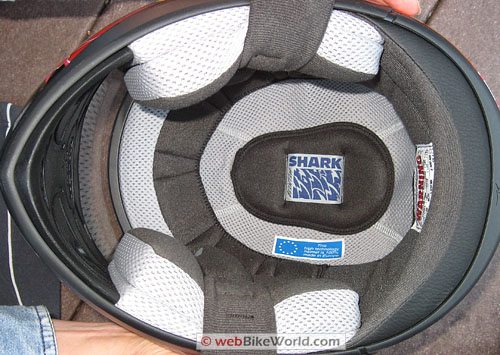
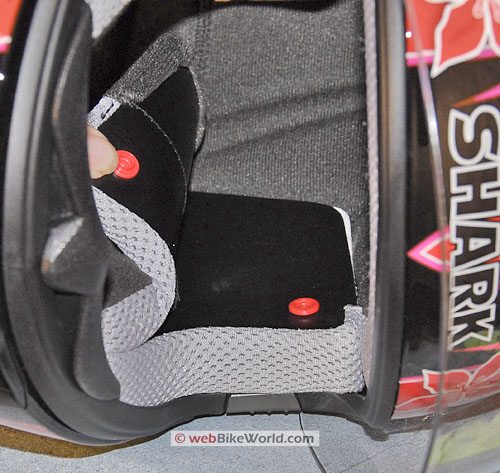
Helmet Liner
The fabric used on the inside of the S 650 is a soft micro-fleece material.
Nearly everything we said about the RSi’s liner holds true for the S 650; it has a nice finish and is relatively comfortable, other than the thin padding over the plastic that curiously replaces what should be ear pockets.
The S 650 also has a padded finish on the inside of the chin guard, an area that is often overlooked.
Score: The S 650’s liner is maybe slightly better than average; the lack of ear pockets may bother some riders, so I’ll give it a score of good on this criteria.
Ventilation
Simpler is better — sometimes, anyway. The S 650 has a single open/closed chin vent that is designed to flow some of the air through a pair of holes in the back of the chin bar and on to the rider’s face.
The rest of the air is directed behind the vestigial breath guard and on to the back of the face shield.
The top vent is similar to current Shark design as used on the RSi. It’s a flush fit when closed, and it opens when it is pushed down, directing air into the top of the helmet through a scoop that is reminiscent of the old NACA ducts. A small serrated protrusion can be pulled forward to release the spring pressure and allow the “trap door” vent to close.
I don’t really feel much of a difference in air flow when the chin vent is open.
That’s because, as is common on many helmets, there’s a lot of air coming up from underneath anyway. However, the top vent does seem to flow more air than I’d expect, and it does so without undue noise.
Score: I’ll give it a very good for venting.
Where to Buy Shark S 650 Helmet
Check Reviews & Prices on Amazon Check Reviews & Prices On RevZillaSee More Motorcycle Helmets, Motorcycle Visor, Motorcycle Intercom
Noise and Sound Levels
The Shark S 650 has a split personality when it comes to noise levels. The top vent seems quieter than it should be — I was expecting a lot of “blowing over a Coke bottle” type whistling from the relatively large open vent, but I don’t hear it.
The sleek shell is without the “aerodynamic” appendages that can often be the cause of high-pitched noise, so no problem in that department either.
However, the S 650 seems to me to have an over-abundance of wind rushing noise that originates at the bottom of the helmet.
This is often a problematic location and is the source of much low-frequency turbulence-induced helmet noise that can sometimes be attenuated with better or more padding around the bottom of the helmet or helmet “skirts” that block the wind.
See the wBW reviews of the Windjammer wind blocker and the NOJ Quiet Rider wind blocker for more information.
I notice tht the S 650 has about the same elevated levels of noise whether I’m riding an unfaired bike or behind a short fairing; the noise is absent only when I ride behind the fairing of the big BMW K1100LT.
Now this may be due to the difference in my head shape and the relatively extreme “long oval” shape of the S 650.
There are many causes of helmet noise, and the fit around the bottom of the helmet is one of them. I’m not an extreme long oval shape, so I suspect there may be too much space around the bottom of the helmet, causing more noise from this area than normal.
Since we couldn’t find a rider nearby who was a perfect match for the S 650, this question will remain unanswered until, I hope, we get some feedback from owners (in the comments section below).
Note that we always wear earplugs and an extra helmet liner when we ride. See the wBWEarplugs and Hearing Protection page for more information and a list of earplug reviews that we’ve posted on the site.
The bottom line is that the S 650 seems relatively quiet up top but, for me anyway, creates a loud middle-frequency wind rushing noise around the bottom.
Score: This is a tough one — but I’ll give it a good rating for now.
Chin Strap
S 650 helmets sold in the U.S. and Australia use a D-ring attachment system; Shark apparently supplies a “quick release” system in Europe.
Unlike the RSi, the S 650 has a slightly longer than normal chin strap. Like the RSi, the S 650 has a vinyl loop sewn on to the strap to hold the loose end. The loose end is finished with a nice vinyl tip though.
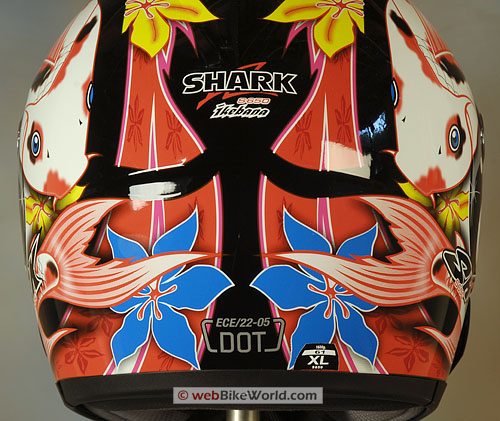
Safety Standards
The S 650 has safety standard markings that are rarely seen in the U.S.A: DOT and ECE 22.05. Many motorcycle owners have written to us inquiring about helmets that meet these standards only, so here’s your answer.
Conclusion
The Shark S 650 is an exceptional helmet in the under $200.00 market…if, that is, it fits.
This is one of those helmets that should not be purchased unless you’re sure it will fit comfortably and correctly.
But for the many motorcyclists with long oval head shapes who are looking for a very reasonably priced helmet with high levels of quality and Shark levels of technology, look no further.
| wBW Review: Shark S 650 Helmet | |
|---|---|
| Manufacturer: Shark Helmets | List Price (2007): $179.95-$197.95 |
| Colors: Solids and graphics. | Made In: EU |
| Review Date: August 2007 | |
Where to Buy Shark S 650 Helmet
Check Reviews & Prices on Amazon Check Reviews & Prices On RevZillaSee More Motorcycle Helmets, Motorcycle Visor, Motorcycle Intercom
Owner Comments and Feedback
See details on submitting comments.
From “A.L.” (10/10): “It seems like Shark helmets are often discounted at various online retailers. So for less than $100 bucks I took at a shot at the S650.
I got the “Dest” Black Blue Silver and it looks absolutely beautiful. Fit and comfort is standard, but the noise is definitely one of the highest (compare to my Shark RSI, HJC CL-SP, Sparx S-07, AGV K3, and even a cheapie no name one).
Despite that major issue, I still got another Dest (Red white and black) just because it looks like a $300 dollar helmet. Shark really got their helmet color and artwork right, Arai and Shoei got nothing on them. I wear a Large, same as all ones I have above.”
From “J.L.” (10/09): “This was my first ever on-line helmet purchase. I bought based on your reviews regarding head shape and quality, balanced by price.
You got the head shape spot on and this helmet fits quite similarly to my old Arai Quantum 1 (that’s the long-oval version of the Quantum, before Arai offered the rounder shaped Quantum 2). The fit is the best I’ve ever tried so I find it quite comfortable.
The ear spaces are not spaces so it can be a bit difficult to get your ears unfolded one the helmet is on, but not a big problem. I have no trouble getting my glasses on though. I wear rather small glasses with fairly straight arms.
The overall quality seems excellent, air flow is excellent, face shield fogging is about the same as my Arai, that is, no problem at all when moving, and I had no problem at stoplights until the weather got into the 40’s (F).
But this helmet is noisy! The wind rushing is loud but not too bad — but between about 35 mph and 50 mph the whistling is quite bothersome. I inspected the helmet and found slight gaps at points around the vent covers.
I used a silicone bathtub sealant and the gaps are no more (you cant see the sealant at all either – gloss white on gloss white and the cracks were quite small). The whistling however, continues unabated.
I tried a temporary weather-stripping seal around the face shield. There is a thin gap in the gasket at the back of each side of the face shield that seems to be by design (this does not appear to let rain in by the way, though I haven’t yet had a very through testing of that).
Eliminating the gap with weather-stripping made no difference to the noise.
I have high hopes of eliminating the noise with a Windjammer or something similar. The noise stops if I hold my hand along the underside of the helmet and against my jaw line.
The whistling noise stops if I just hold my my arm anywhere in front of my chest, so I imagine that the type of fairing you have will make a difference as well (I ride a CBR600 F4)
Overall I’m happy with the helmet, though I do wish I had spent the extra money for the Shark RSI model (review), which is supposedly the same kind of fit – but quieter.”
From “J.T.”: “After some research, but primarily on the webBikeWorld.com review, my wife and I decided to purchase two S650 Frame motorcycle helmets. We ride a BMW R1100RS with the short fairing.
I was shocked at the performance of the S650. From 35mph, and up, the helmet allowed a ‘blast’ of air to enter the helmet, and this was felt around my ears. As my speed increased, the volume of air and sound increased. By 55mph the noise was deafening.
Added to this noise was the ‘roar’ caused by any cross-wind.
The only experience that I could compare it to would be to be seated directly next to two open car windows at 60mph. Even though I used ear plugs on my last twenty mile ride from work, my ears were still loudly ringing after three hours after getting off the bike.
Closely examining the helmet reveals why it performs so poorly even compared to my under-$100 ZIR Sonic; there is a gap of over one inch in the face shield seal directly in front of each hinge mechanism.
Since there is not a continuous seal between the visor and helmet, air enters freely through the gap and then is able to blast directly on the ears.
I consider the lack of a sealed visor to be a serious design flaw. Besides being exceedingly noisy, what happens if I’m wearing the helmets and it rains? Will the rain flow into the helmet as easily as the air does?
Shark customer service refuses to address the problem since they say, “In addition, SHARK cannot consider subjective considerations related to use of the helmet as defects covered by the warranty: problems with comfort, size, noise or whistling, aerodynamics, etc.”
I don’t consider suffering tinnitus, even when wearing earplugs, as ‘subjective’.”
From “M.T.”: “I would to like to first off thank the editor of webBikeWorld for his great review of the Shark S 650 Helmet as I feel it was pretty on point with how the helmet works and fits.
I recently picked up the Shark S 650 helmet in size Small and in comparison to previous helmets I have owned including HJC and KBC the Shark blows them away for the lower priced market of helmets.
When you take a look at the lining inside the Shark helmet you will notice that the lower neck lining padding on the back has some sort of leather material used on the outside of it to help reduce wear while my KBC was ripping from this same spot from wear.
The inside lining has on the top a spot that has very soft padding that should prevent and help the top of your head when in a crash. This helmet is also very light in comparison to HJC-KBC lids and even Scorpion.
So I can honestly say this helmet is great for those looking for a cheap lid but something that feels safe and does the job. The only problem I have with the helmet is that it can tend to be noisy but that might be more of a reason to save your hearing and wear ear plugs! :->
Enjoy and keep it safe out there.”



No Comment